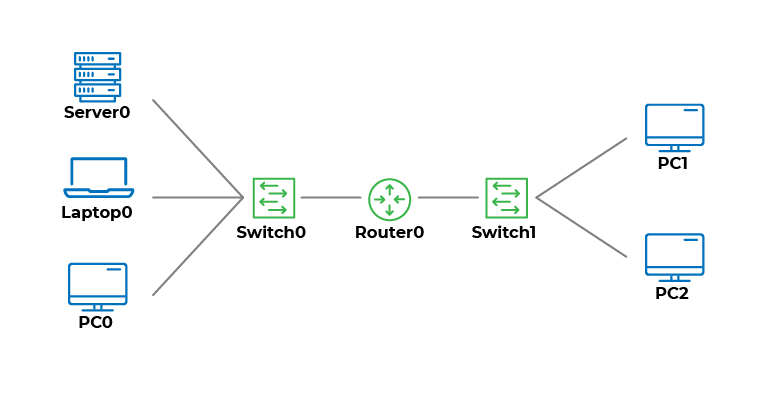
Send Messages
In the previous chapter, you learned to identify your devices via their MAC address. Now you need to establish communication between them. Communicating means exchanging messages, called packets, in the world of network communications.
To check that communication is working between two devices, you’re going to create a packet on one device and send it to another.
And how exactly do I do that?
Don’t panic! Let’s see how to do it in Packet Tracer in the video below:
Simulate Communication on Your Network with Packet Tracer
You’re back at your network design company again, and Mr. Falman has been thinking about your proposal. He’s decided to accept your quote and asks you to implement the architecture you suggested.
Just as a reminder, this is what the full architecture looks like, with your client’s devices on the left and those of the company Cyclade, on the right:

Your manager asks you to work with a more experienced colleague who has already completed many similar projects. He suggests that you configure the network while he takes charge of purchasing and installing the equipment.
To prepare for this task, you decide to simulate everything in Packet Tracer. You’ve already created a model of the full architecture while working on the quote you gave the client. All that remains to be done is to test communication between the devices.
The client asks you to keep his current IP addresses:
1.1.1.1 for the server
1.1.1.2 for the desktop computer
1.1.1.3 for the laptop
Over to You!
Assign the IP addresses to the client’s three devices and test communication.
You’ll need to create a packet on the desktop computer, send it to the server, and check that it arrives.
Answers
You’ve managed to establish communication within a local network. Well done!
Using the MAC address of your devices, the switch can identify where a message is coming from and send it in the desired direction, i.e., to the correct port.
So is everything ready to use now? Can my devices communicate with any other device and with the internet?
Not yet! For the moment, your devices can only communicate within a local network.
For your devices to have internet access, or access to another network, the packets need to be able to travel between networks. To do this, the MAC address is not enough. You need another type of address that we haven’t used yet: an IP address.
Let’s Recap!
Communications within a local network use MAC addresses.
When a switch receives a packet, it uses the MAC address to determine which of the ports it should send it to.
You have to assign an IP address to the device to create a packet.
Well done, you’ve successfully configured communication on a local network! Let’s go to the next chapter to learn more about IP addresses.
